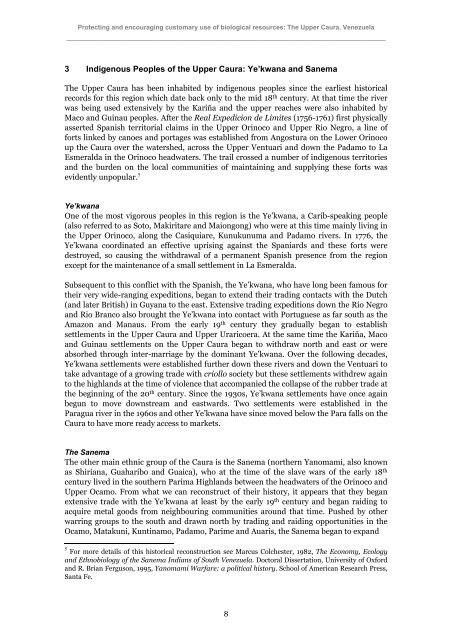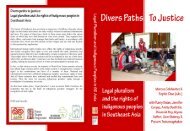The Upper Caura, Venezuela - Forest Peoples Programme
The Upper Caura, Venezuela - Forest Peoples Programme
The Upper Caura, Venezuela - Forest Peoples Programme
You also want an ePaper? Increase the reach of your titles
YUMPU automatically turns print PDFs into web optimized ePapers that Google loves.
Protecting and encouraging customary use of biological resources: <strong>The</strong> <strong>Upper</strong> <strong>Caura</strong>, <strong>Venezuela</strong>_________________________________________________________________________________________3 Indigenous <strong>Peoples</strong> of the <strong>Upper</strong> <strong>Caura</strong>: Ye’kwana and Sanema<strong>The</strong> <strong>Upper</strong> <strong>Caura</strong> has been inhabited by indigenous peoples since the earliest historicalrecords for this region which date back only to the mid 18 th century. At that time the riverwas being used extensively by the Kariña and the upper reaches were also inhabited byMaco and Guinau peoples. After the Real Expedicion de Limites (1756-1761) first physicallyasserted Spanish territorial claims in the <strong>Upper</strong> Orinoco and <strong>Upper</strong> Rio Negro, a line offorts linked by canoes and portages was established from Angostura on the Lower Orinocoup the <strong>Caura</strong> over the watershed, across the <strong>Upper</strong> Ventuari and down the Padamo to LaEsmeralda in the Orinoco headwaters. <strong>The</strong> trail crossed a number of indigenous territoriesand the burden on the local communities of maintaining and supplying these forts wasevidently unpopular. 5Ye’kwanaOne of the most vigorous peoples in this region is the Ye’kwana, a Carib-speaking people(also referred to as Soto, Makiritare and Maiongong) who were at this time mainly living inthe <strong>Upper</strong> Orinoco, along the Casiquiare, Kunukunuma and Padamo rivers. In 1776, theYe’kwana coordinated an effective uprising against the Spaniards and these forts weredestroyed, so causing the withdrawal of a permanent Spanish presence from the regionexcept for the maintenance of a small settlement in La Esmeralda.Subsequent to this conflict with the Spanish, the Ye’kwana, who have long been famous fortheir very wide-ranging expeditions, began to extend their trading contacts with the Dutch(and later British) in Guyana to the east. Extensive trading expeditions down the Rio Negroand Rio Branco also brought the Ye’kwana into contact with Portuguese as far south as theAmazon and Manaus. From the early 19 th century they gradually began to establishsettlements in the <strong>Upper</strong> <strong>Caura</strong> and <strong>Upper</strong> Uraricoera. At the same time the Kariña, Macoand Guinau settlements on the <strong>Upper</strong> <strong>Caura</strong> began to withdraw north and east or wereabsorbed through inter-marriage by the dominant Ye’kwana. Over the following decades,Ye’kwana settlements were established further down these rivers and down the Ventuari totake advantage of a growing trade with criollo society but these settlements withdrew againto the highlands at the time of violence that accompanied the collapse of the rubber trade atthe beginning of the 20 th century. Since the 1930s, Ye’kwana settlements have once againbegun to move downstream and eastwards. Two settlements were established in theParagua river in the 1960s and other Ye’kwana have since moved below the Para falls on the<strong>Caura</strong> to have more ready access to markets.<strong>The</strong> Sanema<strong>The</strong> other main ethnic group of the <strong>Caura</strong> is the Sanema (northern Yanomami, also knownas Shiriana, Guaharibo and Guaica), who at the time of the slave wars of the early 18 thcentury lived in the southern Parima Highlands between the headwaters of the Orinoco and<strong>Upper</strong> Ocamo. From what we can reconstruct of their history, it appears that they beganextensive trade with the Ye’kwana at least by the early 19 th century and began raiding toacquire metal goods from neighbouring communities around that time. Pushed by otherwarring groups to the south and drawn north by trading and raiding opportunities in theOcamo, Matakuni, Kuntinamo, Padamo, Parime and Auaris, the Sanema began to expand5 For more details of this historical reconstruction see Marcus Colchester, 1982, <strong>The</strong> Economy, Ecologyand Ethnobiology of the Sanema Indians of South <strong>Venezuela</strong>. Doctoral Dissertation, University of Oxfordand R. Brian Ferguson, 1995, Yanomami Warfare: a political history. School of American Research Press,Santa Fe.8
















